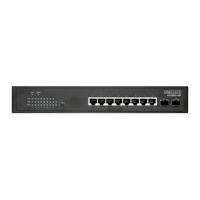Chapter 29
| IP Routing Commands
Open Shortest Path First (OSPFv2)
– 854 –
area virtual-link This command defines a virtual link. To remove a virtual link, use the no form with
no optional keywords. To restore the default value for an attribute, use the no form
with the required keyword.
Syntax
area area-id virtual-link router-id
[authentication][dead-interval seconds] [hello-interval seconds]
[retransmit-interval seconds] [transmit-delay seconds]
no area area-id virtual-link router-id
[authentication | dead-interval | hello-interval | retransmit-interval |
transmit-delay]
area area-id virtual-link router-id
authentication [message-digest | null]
[authentication-key key | message-digest-key key-id md5 key]
no area area-id virtual-link router-id
authentication [authentication-key |
message-digest-key key-id]
area area-id virtual-link router-id
[authentication-key
key | message-digest-key key-id md5 key]
no area area-id virtual-link router-id
[authentication-key | message-digest-key key-id]
area-id - Identifies the transit area for the virtual link.The area ID can be in
the form of an IPv4 address or as a four octet unsigned integer ranging
from 0-4294967295.
router-id - Router ID of the virtual link neighbor. This specifies the Area
Border Router (ABR) at the other end of the virtual link. To create a virtual
link, enter this command for an ABR at both ends of the link. One of the
ABRs must be next to the isolated area and the transit area at one end of
the link, while the other ABR must be next to the transit area and backbone
at the other end of the link.
dead-interval seconds - Specifies the time that neighbor routers will wait
for a hello packet before they declare the router down. This value must be
the same for all routers attached to an autonomous system. (Range: 1-
65535 seconds; Default: 4 x hello interval, or 40 seconds)
hello-interval seconds - Specifies the transmit delay between sending
hello packets. Setting the hello interval to a smaller value can reduce the
delay in detecting topological changes, but will increase the routing traffic.
This value must be the same for all routers attached to an autonomous
system. (Range: 1-65535 seconds; Default: 10 seconds)
retransmit-interval seconds - Specifies the interval at which the ABR
retransmits link-state advertisements (LSA) over the virtual link. The
retransmit interval should be set to a conservative value that provides an
adequate flow of routing information, but does not produce unnecessary
protocol traffic. However, note that this value should be larger for virtual
links. (Range: 1-3600 seconds; Default: 5 seconds)

